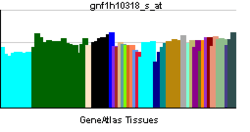GPR139
Probable G-protein coupled receptor 139 is a protein that in humans is encoded by the GPR139 gene.[4][5]
References
- ↑ "Drugs that physically interact with Probable G-protein coupled receptor 139 view/edit references on wikidata".
- ↑ "Human PubMed Reference:".
- ↑ "Mouse PubMed Reference:".
- ↑ Vassilatis DK, Hohmann JG, Zeng H, Li F, Ranchalis JE, Mortrud MT, Brown A, Rodriguez SS, Weller JR, Wright AC, Bergmann JE, Gaitanaris GA (Apr 2003). "The G protein-coupled receptor repertoires of human and mouse". Proc Natl Acad Sci U S A. 100 (8): 4903–8. doi:10.1073/pnas.0230374100. PMC 153653
 . PMID 12679517.
. PMID 12679517. - ↑ "Entrez Gene: GPR139 G protein-coupled receptor 139".
Further reading
- Ottolenghi C, Fellous M, Barbieri M, McElreavey K (2002). "Novel paralogy relations among human chromosomes support a link between the phylogeny of doublesex-related genes and the evolution of sex determination.". Genomics. 79 (3): 333–43. doi:10.1006/geno.2002.6711. PMID 11863363.
- Takeda S, Kadowaki S, Haga T, et al. (2002). "Identification of G protein-coupled receptor genes from the human genome sequence.". FEBS Lett. 520 (1–3): 97–101. doi:10.1016/S0014-5793(02)02775-8. PMID 12044878.
- Gloriam DE, Schiöth HB, Fredriksson R (2005). "Nine new human Rhodopsin family G-protein coupled receptors: identification, sequence characterisation and evolutionary relationship". Biochim. Biophys. Acta. 1722 (3): 235–46. doi:10.1016/j.bbagen.2004.12.001. PMID 15777626.
- Matsuo A, Matsumoto S, Nagano M, et al. (2005). "Molecular cloning and characterization of a novel Gq-coupled orphan receptor GPRg1 exclusively expressed in the central nervous system". Biochem. Biophys. Res. Commun. 331 (1): 363–9. doi:10.1016/j.bbrc.2005.03.174. PMID 15845401.


 . PMID 12679517.
. PMID 12679517.